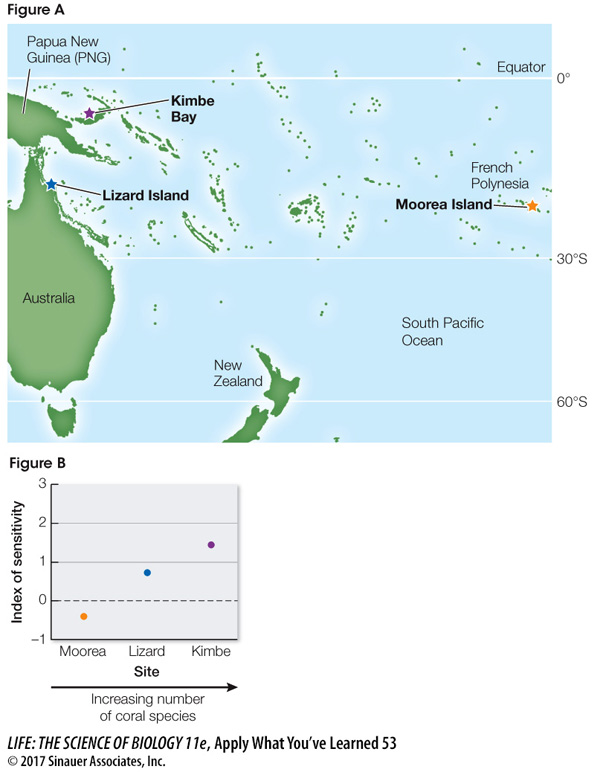Apply What You’ve Learned
Review
53.4 Hypotheses to explain the causes of latitudinal variations in diversity include species diversification rate, species diversification time, and productivity.
53.5 The species–
Original Paper: Holbrook, S. J. et al. 2015. Reef fishes in biodiversity hotspots are at greatest risk from loss of coral species. PLoS ONE 10: e0124054.
As you learned in Chapter 1, climate change and human activities pose substantial threats to tropical coral reefs. These species-
A group of researchers studied the species diversity of reef fishes, which depend on coral reefs for food and habitat. They found a positive relationship between fish species diversity and coral species diversity. Coral reefs support a variety of fish species, including both generalists and specialists, but as coral diversity increases, the number of fish specialists—
1166
The researchers set up identical experiments in three geographic locations across the Indo-
At each of the three reef sites across the Indo-
Results for the final count are shown in Figure B. Researchers calculated an “index of sensitivity” to evaluate the relationship between the number of coral species in the experimental plots and the number of fish species that inhabited the plots. The zero line indicates no difference in fish species diversity; positive values indicate proportionally greater decreases in fish species present with declining coral species in the plots. That is, fish species from the Kimbe Bay site were more sensitive to changes in the number of coral species than were fish species from lower diversity areas, and they were more likely to suffer local extinctions.

Questions
Question 1
What do the results of this experiment suggest about the relationship between the number of fish species and the species diversity of corals on the reefs they inhabit? Explain how this insight might be used to preserve or maintain coral reef ecosystems currently under threat.
According to Figure B, the ability of reef fish species to respond to loss of corals is inversely proportional to the number of coral species present. The results show that fish from more diverse areas (PNG) were more sensitive to changes in the number of coral species than were fish from lower diversity areas (GBR, FP). This tendency for fish species to decline under lower coral diversity situations is a consequence of the fact that more diverse reefs contain more specialized fish species (species that depend for food and/or shelter on one or a very few coral species). These results suggest that if managers want to protect the most fish species possible, they should focus their efforts on the most diverse coral reefs where these specializations occur.
Question 2
Based on the map, at which sites do you think the species diversity of corals and fish would be most affected by the process of dispersal, or immigration, of species to the site(s), and which would be least affected?
The PNG and GBR sites are relatively close together. Thus it would be easier for organisms, such as fish and coral larvae, to move between and colonize these sites. These colonization events could serve to increase species diversity at each site. The FP site is very isolated, and the probability of new species from the other sites reaching this area is much lower.
Question 3
What major factors could have resulted in the development of the high coral reef species diversity at the Kimbe Bay site? Why do the other sites have lower species diversity?
The PNG site is very near the equator, so it has a warm, stable environment. One theory that could explain species diversity as it relates to latitude is the species diversification time hypothesis. Equatorial species have had a very long time to evolve, unaffected by conditions (such as glaciation) that caused extinctions at higher latitudes. The other sites are slightly farther from the equator, which might make them slightly less likely to reach high levels of diversity. Another explanation might be the theory of island biogeography and the related concept of species–area relationship. That is, higher species diversity is associated with greater land area, and isolated islands will show decreasing numbers of species with increasing distance from a source of new species. Although both PNG and GBR are islands, both sites are close to other islands and to a large landmass (Australia), making them likely to be colonized by species from these areas. The FP site is much more isolated and therefore much less likely to be colonized.
Question 4
As climate change progresses, ocean waters are becoming both warmer and more acidic, causing the decline in corals worldwide. What effect would these changes in coral reef species diversity likely have on fish species diversity in the three areas? Explain possible reasons for these changes and what variations might occur in each area.
As climate change progresses, coral reefs are likely to degrade and show local extinctions of coral species. The experiment shows that reefs with higher coral diversity are likely to have greater declines in fish species number as well. Thus, if climate change continues on its present course and coral reefs continue to decline in the future, the reefs that remain will likely have lower fish species diversity. Because areas with high coral diversity have more specialized fish species, these species will be most at risk. PNG—
Go to LaunchPad for the eBook, LearningCurve, animations, activities, flashcards, and additional resources and assignments.